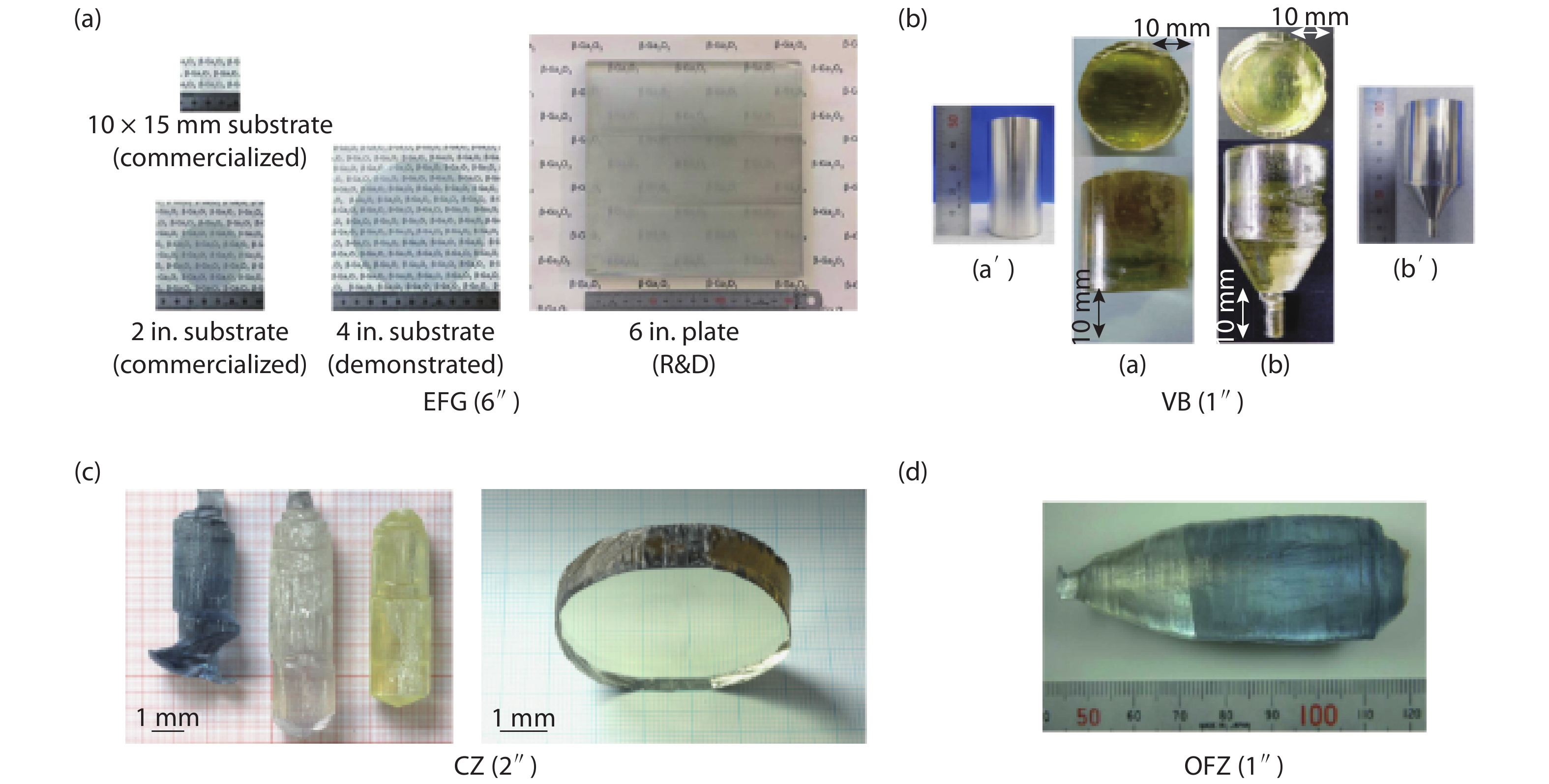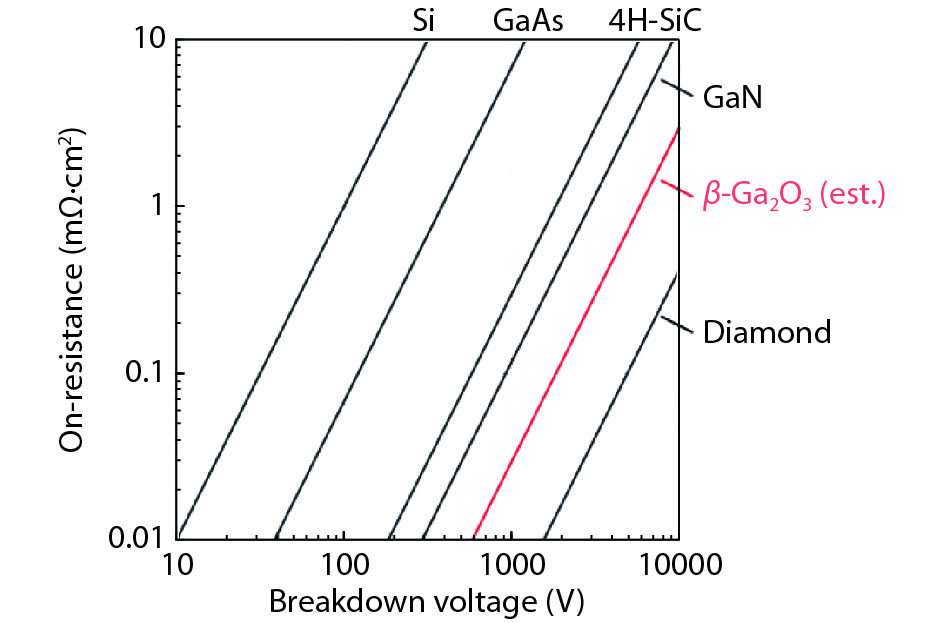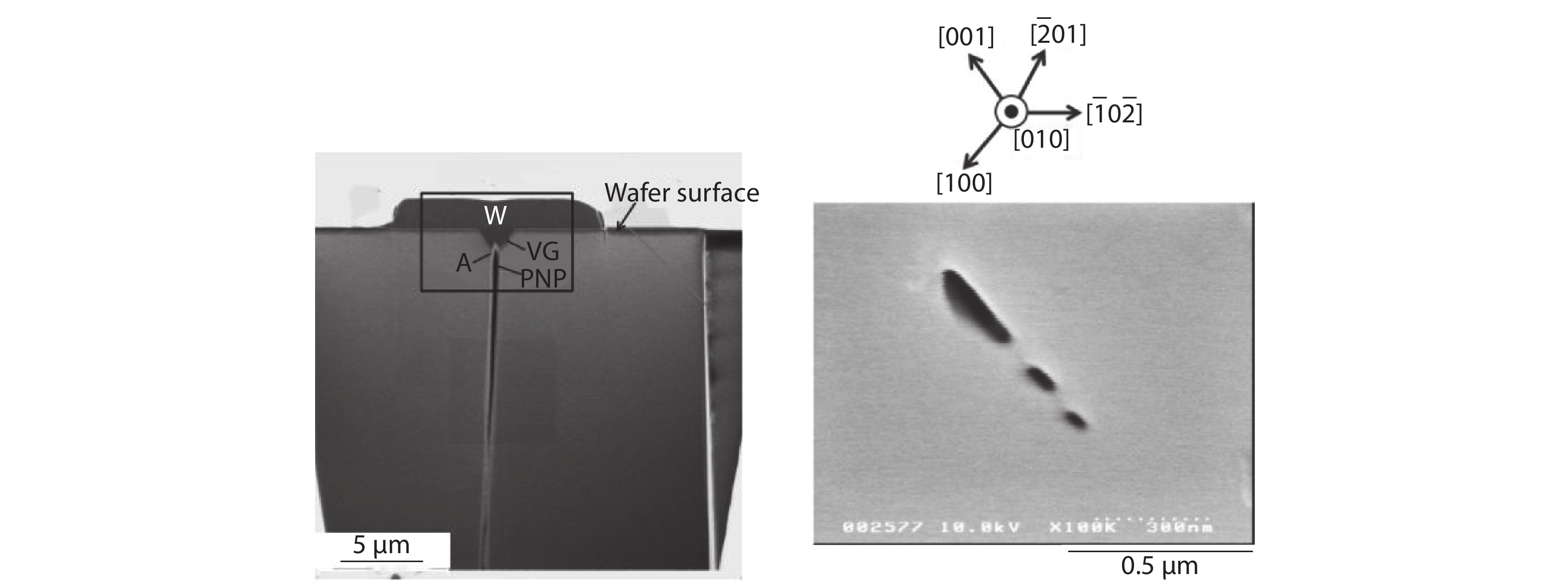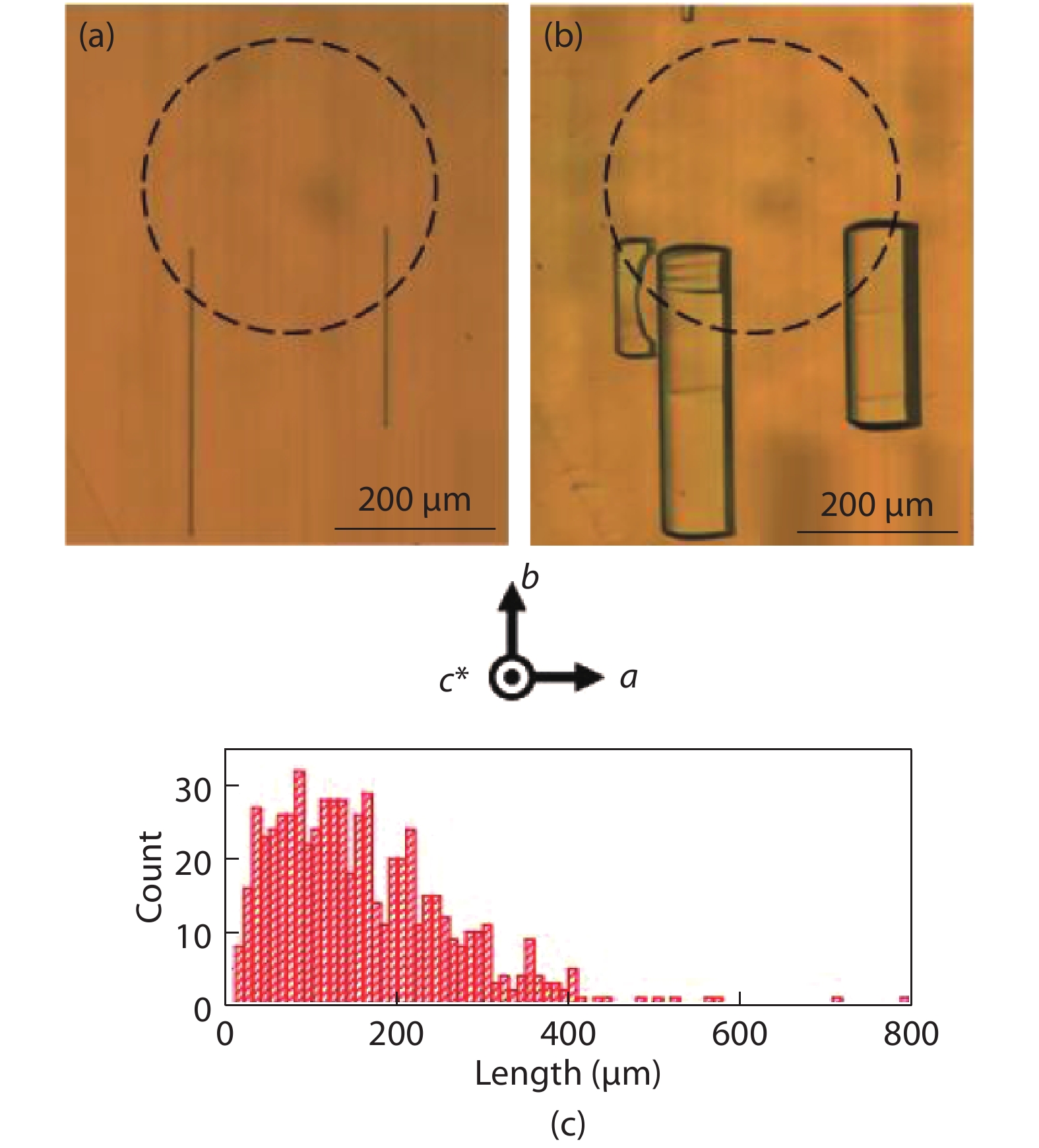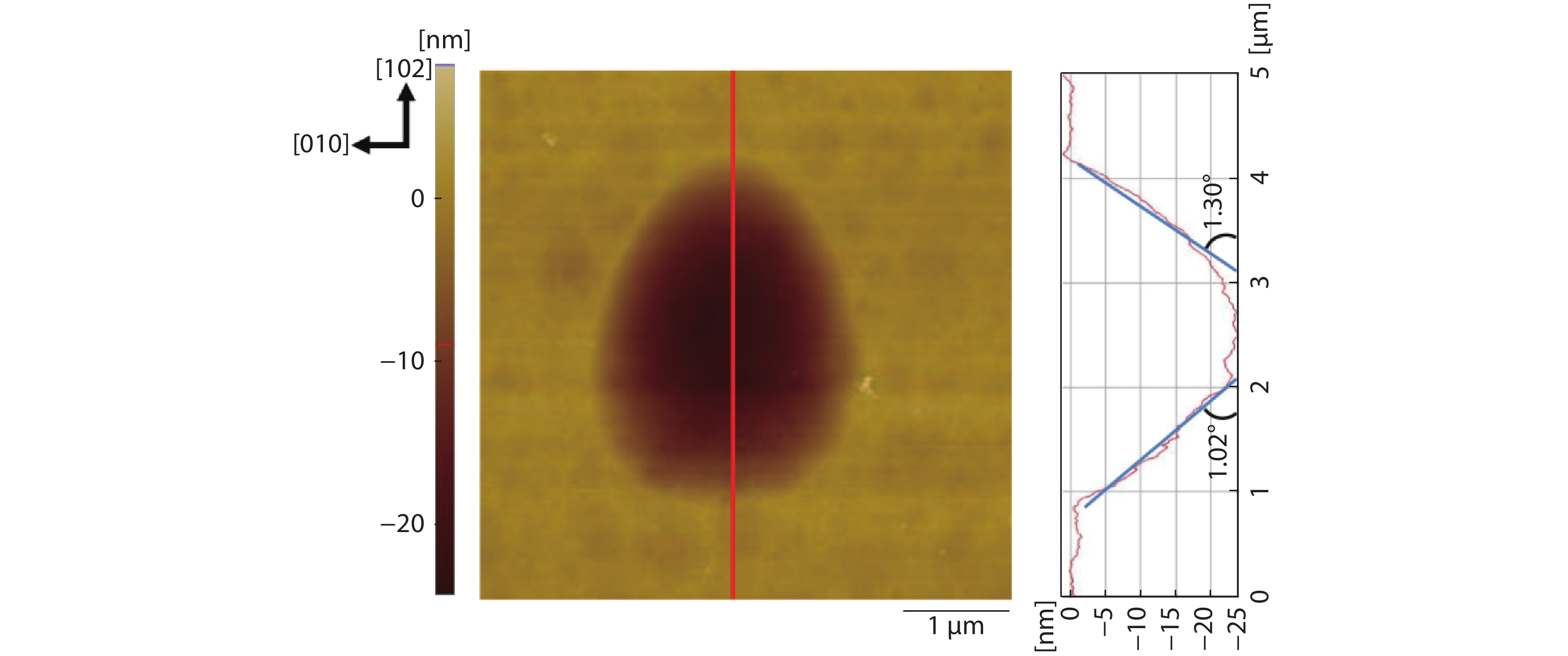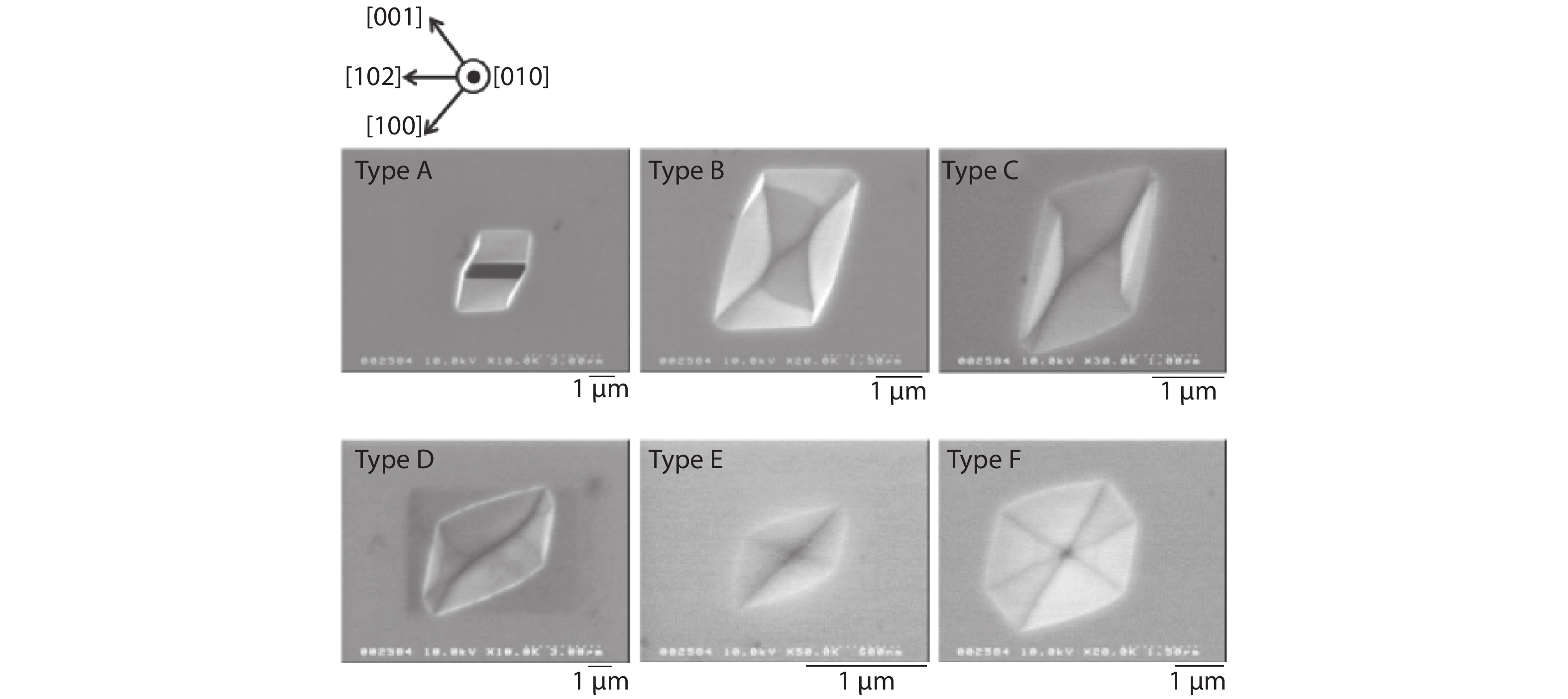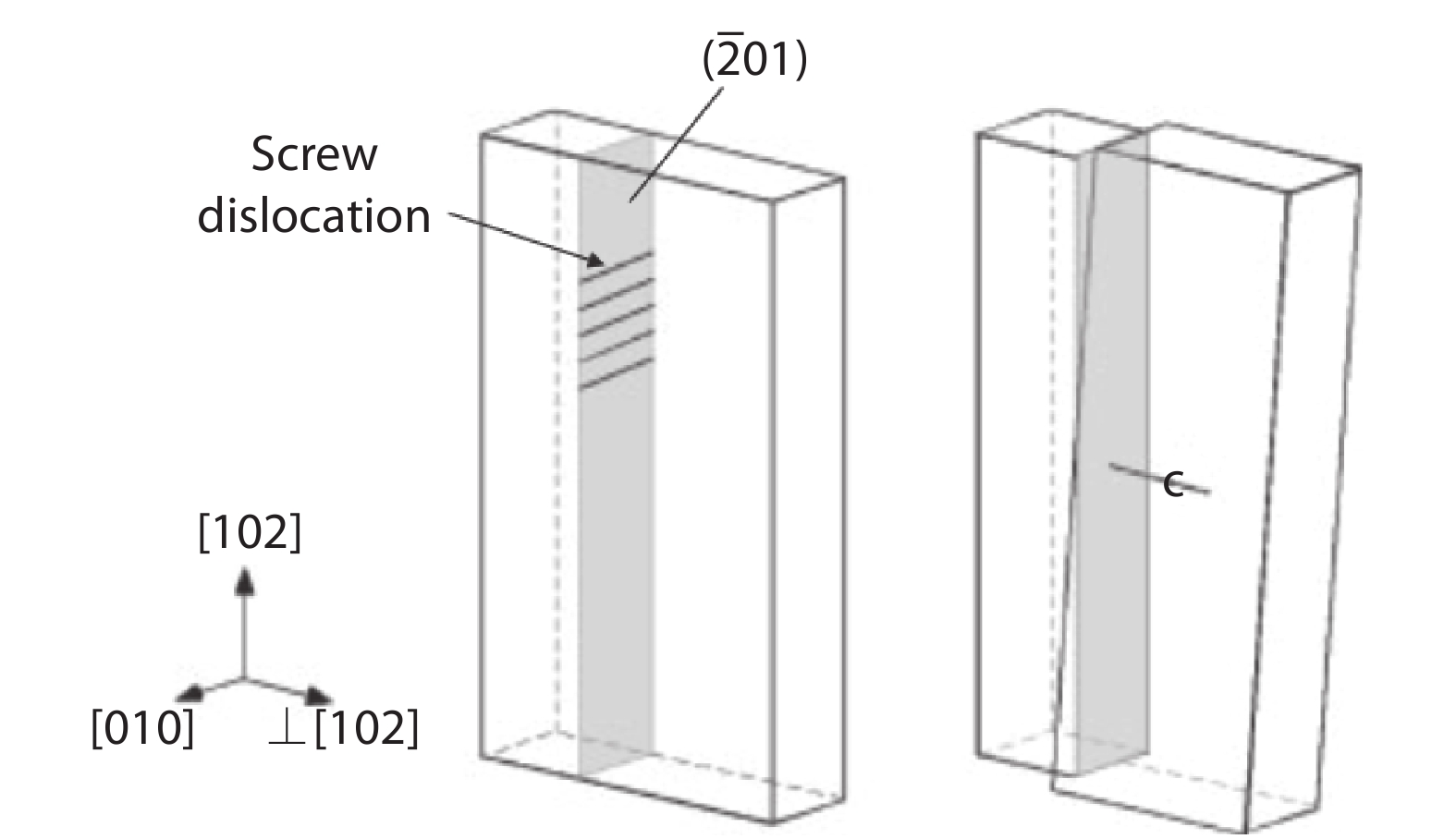| Citation: |
Bo Fu, Zhitai Jia, Wenxiang Mu, Yanru Yin, Jian Zhang, Xutang Tao. A review of β-Ga2O3 single crystal defects, their effects on device performance and their formation mechanism[J]. Journal of Semiconductors, 2019, 40(1): 011804. doi: 10.1088/1674-4926/40/1/011804
****
B Fu, Z T Jia, W X Mu, Y R Yin, J Zhang, X T Tao, A review of β-Ga2O3 single crystal defects, their effects on device performance and their formation mechanism[J]. J. Semicond., 2019, 40(1): 011804. doi: 10.1088/1674-4926/40/1/011804.
|
A review of β-Ga2O3 single crystal defects, their effects on device performance and their formation mechanism
DOI: 10.1088/1674-4926/40/1/011804
More Information
-
Abstract
As a wide-bandgap semiconductor (WBG), β-Ga2O3 is expected to be applied to power electronics and solar blind UV photodetectors. In this review, defects in β-Ga2O3 single crystals were summarized, including dislocations, voids, twin, and small defects. Their effects on device performance were discussed. Dislocations and their surrounding regions can act as paths for the leakage current of SBD in single crystals. However, not all voids lead to leakage current. There’s no strong evidence yet to show small defects affect the electrical properties. Doping impurity was definitely irrelated to the leakage current. Finally, the formation mechanism of the defects was analyzed. Most small defects were induced by mechanical damages. The screw dislocation originated from a subgrain boundary. The edge dislocation lying on a plane slightly tilted towards the (102) plane, the (101) being the possible slip plane. The voids defects like hollow nanopipes, PNPs, NSGs and line-shaped grooves may be caused by the condensation of excess oxygen vacancies, penetration of tiny bubbles or local meltback. The nucleation of twin lamellae occurred at the initial stage of " shoulder part” during the crystal growth. These results are helpful in controlling the occurrence of crystal defects and improving the device performance.-
Keywords:
- β-Ga2O3,
- crystal defects,
- device performance,
- formation mechanism
-
References
[1] Baldini M, Galazka Z, Wagner G. Recent progress in the growth of β-Ga2O3 for power electronics applications. Mater Sci Semicond Process, 2017, 78, 132 doi: 10.1016/j.mssp.2017.10.040[2] Pearton S J, Yang J, Cary IV P H, et al. A review of Ga2O3 materials, processing, and devices. Appl Phys Rev, 2018, 5(1): 011301. doi: 10.1063/1.5006941[3] Jang S, Jung S, Beers K, et al. A comparative study of wet etching and contacts on (2-01) and (010) oriented β-Ga2O3. J Alloys Compd, 2018, 731: 118-125. doi: 10.1016/j.jallcom.2017.09.336[4] Ghose S. Growth and characterization of wide bandgap semiconductor oxide thin films. PhD Dissertations, Texas State University, 2017[5] Stepanov S I, Nikolaev V I, Bougrov V E, et al. Gallium oxide: properties and applica a review. Rev Adv Mater Sci, 2016, 44: 63[6] Harwig T, Wubs G J, Dirksen G J. Electrical properties of β-Ga2O3 single crystals. Solid State Commun, 1976, 18(9/10): 1223 doi: 10.1016/0038-1098(76)90944-3[7] Chase A O. Growth of β-Ga2O3 by the Verneuil Technique. J Am CeramSoc, 1964, 47(9): 470 doi: 10.1111/jace.1964.47.issue-9[8] Lorenz M R, Woods J F, Gambino R J. Some electrical properties of the semiconductor β-Ga2O3. J Phys Chem of Solids, 1967, 28(3): 403 doi: 10.1016/0022-3697(67)90305-8[9] Víllora E G, Yamaga M, Inoue T, et al. Optical spectroscopy study on β-Ga2O3. Jpn J Appl Phys, 2002, 41(6A): L622 doi: 10.1143/jjap.41.l622[10] Zhang J, Li B, Xia C, et al. Growth and spectral characterization of β-Ga2O3 single crystals. J Phys Chem Solids, 2006, 67(12): 2448 doi: 10.1016/j.jpcs.2006.06.025[11] Víllora E G; Shimamura K; Yoshikawa Y, et al. Large-size β-Ga2O3 single crystals and wafers. J Cryst Growth 2004, 270 (3/4), 420 doi: 10.1016/j.jcrysgro.2004.06.027[12] Ohba E, Kobayashi T, Kado M, et al. Defect characterization of β-Ga2O3 single crystals grown by vertical Bridgman method. Jpn J Appl Phys, 2016, 55(12): 1202BF. doi: 10.7567/JJAP.55.1202BF[13] Hoshikawa K; Ohba E; Kobayashi T; et al. Growth of β-Ga2O3 single crystals using vertical Bridgman method in ambient air. J Cryst Growth 2016, 447: 36- doi: 10.1016/j.jcrysgro.2016.04.022[14] Hideo A; Kengo N; Hidetoshi T; et al. Growth of β-Ga2O3 single crystals by the edge-defined, film fed growth method. Jpn J Appl Phys 2008, 47, (11R): 8506. doi: 10.1143/JJAP.47.8506[15] Bell R O. Modeling of the time dependence of EFG crystal growth. J Cryst Growth, 1990, 104(1): 23 doi: 10.1016/0022-0248(90)90303-3[16] Braescu L, Duffar T. Effect of buoyancy and Marangoni forces on the dopant distribution in a single crystal fiber grown from the melt by edge-defined film-fed growth (EFG) method. J Cryst Growth, 2008, 310(2): 484 doi: 10.1016/j.jcrysgro.2007.10.046[17] Bunoiu O, Nicoara I, Santailler J L, et al. Fluid flow and solute segregation in EFG crystal growth process. J Cryst Growth, 2005, 275(1/2): e799 doi: 10.1016/j.jcrysgro.2004.11.052[18] Galazka Z, Uecker R, Fornari R. A novel crystal growth technique from the melt: levitation-assisted self-seeding crystal growth method. J Cryst Growth, 2014, 388: 61 doi: 10.1016/j.jcrysgro.2013.11.049[19] Shimamura K, Villora E G. Czochralski-Based growth and characteristics of selected novel single crystals for optical applications. Acta Phys Polon A, 2013, 124(2): 265 doi: 10.12693/APhysPolA.124.265[20] Galazka Z, Uecker R, Irmscher K, et al. Czochralski growth and characterization of β-Ga2O3 single crystals. Cryst Res Technol, 2010, 45(12): 1229 doi: 10.1002/crat.v45.12[21] Irmscher K, Galazka Z, Pietsch M, et al. Electrical properties of β-Ga2O3 single crystals grown by the Czochralski method. J Appl Phys, 2011, 110(6): 063720. doi: 10.1063/1.3642962[22] Tomm Y, Reiche P, Klimm D, et al. Czochralski grown Ga2O3 crys-tals. J Cryst Growth, 2000, 220(4), 510 doi: 10.1016/S0022-0248(00)00851-4[23] Galazka Z, Uecker R, Klimm D, et al. Scaling-up of bulk β-Ga2O3 single crystals by the Czochralski method. ECS J Solid State Sci Technol, 2017, 6(2): Q3007 doi: 10.1149/2.0021702jss[24] Katz G, Roy R. Flux Growth and characterization of β-Ga2O3 single crystals. J Am Ceram Soc, 1966, 49(3): 168 doi: 10.1111/jace.1966.49.issue-3[25] Chani V I, Inoue K, Shimamura K, et al. Segregation coefficients in β-Ga2O3:Cr crystals grown from a B2O3 based flux. J Cryst Growth, 1993, 132(1/2): 335 doi: 10.1016/0022-0248(93)90278-5[26] Matsumoto T, Aoki M, Kinoshita A, et al, Jpn J Appl Phys, 1974, 13: 1578 doi: 10.1143/JJAP.13.1578[27] Juskowiak H, Pajaczkowska A. Chemical transport of β-Ga2O3 using chlorine as a transporting agent. J Mater Sci, 1986, 21(10): 3430 doi: 10.1007/BF02402983[28] Mastro M A, Kuramata A, Calkins J, et al. Perspective—opportunities and future directions for Ga2O3. ECS J Solid State Sci Technol, 2017, 6(5): 356 doi: 10.1149/2.0031707jss[29] Higashiwaki M, Sasaki K, Kuramata A, et al. Development of gallium oxide power devices. Physl Status Solidi A, 2014, 211(1): 21 doi: 10.1002/pssa.201330197[30] Shimamura K, Víllora E G, Domen K, et al. Epitaxial growth of GaN on (1 0 0) β-Ga2O3 substrates by metalorganic vapor phase epitaxy. Jpn J Appl Phys, 2004, 44(1L): L7. doi: 10.1143/JJAP.44.L7[31] Wellmann P J. Power electronic semiconductor materials for automotive and energy saving applications–SiC, GaN, Ga2O3, and diamond. Zeitschrift für anorganische und allgemeine Chemie, 2017, 643(21): 1312 doi: 10.1002/zaac.v643.21[32] Higashiwaki M, Sasaki K, Kuramata A, et al. Gallium oxide (Ga2O3) metal-semiconductor field-effect transistors on single-crystal β-Ga2O3 (010) substrates. Appl Phys Lett, 2012, 100(1): 013504. doi: 10.1063/1.3674287[33] Higashiwaki M, Sasaki K, Murakami H, et al. Recent progress in Ga2O3 power devices. Semicond Sci Technol, 2016, 31(3): 034001. doi: 10.1088/0268-1242/31/3/034001[34] Ma N, Tanen N, Verma A, et al. Intrinsic electron mobility limits in β-Ga2O3. Appl Phys Lett, 2016, 109(21): 212101. doi: 10.1063/1.4968550[35] Fujita S. Wide-bandgap semiconductor materials: For their full bloom. Jpn J Appl Phys, 2015, 54(3): 030101. doi: 10.7567/JJAP.54.030101[36] Burns R P. Systematics of the evaporation coefficient Al2O3, Ga2O3, In2O3[J]. The Journal of Chemical Physics, 1966, 44(9): 3307 doi: 10.1063/1.1727229[37] Takahashi J, Kanaya M, Fujiwara Y. Sublimation growth of SiC single crystalline ingots on faces perpendicular to the (0001) basal plane. J Cryst Growth, 1994, 135(1/2): 61 doi: 10.1016/0022-0248(94)90726-9[38] Nakai K, Nagai T, Noami K, et al. Characterization of defects in β-Ga2O3 single crystals. Jpn J Appl Phys, 2015, 54(5): 051103. doi: 10.7567/JJAP.54.051103[39] Ueda O, Ikenaga N, Koshi K, et al. Structural evaluation of defects in β-Ga2O3 single crystals grown by edge-defined film-fed growth process. Jpn J Appl Phys, 2016, 55(12): 1202BD. doi: 10.7567/JJAP.55.1202BD[40] Hanada K, Moribayashi T, Uematsu T, et al. Observation of nanometer-sized crystalline grooves in as-grown β-Ga2O3 single crystals. Jpn J Appl Phys, 2016, 55(3): 030303. doi: 10.7567/JJAP.55.030303[41] Neudeck P G, Powell J A. Performance limiting micropipe defects in silicon carbide wafers[J]. IEEE Electron Device Letters, 1994, 15(2): 63 doi: 10.1109/55.285372[42] Crimp M A, Simkin B A, Ng B C. Demonstration of the g· bxu = 0 edge dislocation invisibility criterion for electron channelling contrast imaging. Philosophical Magazine Letters, 2001, 81(12): 833 doi: 10.1080/09500830110088755[43] Hanada K, Moribayashi T, Koshi K, et al. Origins of etch pits in β-Ga2O3 (010) single crystals. Jpn J Appl Phys, 2016, 55(12): 1202BG. doi: 10.7567/JJAP.55.1202BG[44] Oshima T, Hashiguchi A, Moribayashi T, et al. Electrical properties of Schottky barrier diodes fabricated on (001) β-Ga2O3 substrates with crystal defects. Jpn J Appl Phys, 2017, 56(8): 086501. doi: 10.7567/JJAP.56.086501[45] Kasu M, Oshima T, Hanada K, et al. Crystal defects observed by the etch-pit method and their effects on Schottky-barrier-diode characteristics on (-201) β-Ga2O3. Jpn J Appl Phys, 2017, 56(9): 091101. doi: 10.7567/JJAP.56.091101[46] Kuramata A, Koshi K, Watanabe S, et al. High-quality β-Ga2O3 single crystals grown by edge-defined film-fed growth. Jpn J Appl Phys, 2016, 55(12): 12022. doi: 10.7567/JJAP.55.1202A2[47] Galazka Z, Irmscher K, Uecker R, et al. On the bulk β-Ga2O3 single crystals grown by the Czochralski method. J Cryst Growth, 2014, 404: 184 doi: 10.1016/j.jcrysgro.2014.07.021[48] Kasu M, Hanada K, Moribayashi T, et al. Relationship between crystal defects and leakage current in β-Ga2O3 Schottky barrier diodes. Jpn J Appl Phys, 2016, 55(12): 1202BB. doi: 10.7567/JJAP.55.1202BB[49] Assali L V C. Electrically active centers in partial dislocations in semiconductors. Physica B, 2001, 308: 489 doi: 10.1016/S0921-4526(01)00819-5[50] Capan I, Borjanović V, Pivac B. Dislocation-related deep levels in carbon rich p-type polycrystalline silicon. Sol Energy Mater Sol Cells, 2007, 91(10): 931 doi: 10.1016/j.solmat.2007.02.011[51] Ikonić Z, Srivastava G P, Inkson J C. Electronic properties of twin boundaries and twinning superlattices in diamond-type and zinc-blende-type semiconductors. Phys Rev B, 1993, 48(23): 17181. doi: 10.1103/PhysRevB.48.17181[52] Yamaguchi H, Kuramata A, Masui T. Slip system analysis and X-ray topographic study on β-Ga2O3. Superlattices Microstruct, 2016, 99: 99 doi: 10.1016/j.spmi.2016.04.030[53] Read W T. Dislocations in crystals. New York: McGraw-Hill, 1953.[54] Frank F C. Capillary equilibria of dislocated crystals. Acta Crystallographica, 1951, 4(6): 497 doi: 10.1107/S0365110X51001690[55] Dash W C. Silicon crystals free of dislocations. J Appl Phys, 1958, 29(4): 736 doi: 10.1063/1.1723264[56] Dash W C. Improvements on the Pedestal Method of Growing Silicon and Germanium Crystals. J Appl Phys, 1960, 31(4): 736 doi: 10.1063/1.1735682[57] Taishi T, Huang X, Yonenaga I, et al. Behavior of the edge dislocation propagating along the growth direction in Czochralski Si crystal growth. J Cryst Growth, 2005, 275(1/2): e2147 doi: 10.1016/j.jcrysgro.2004.11.287[58] Taishi T, Ohno Y, Yonenaga I, et al. Influence of seed/crystal interface shape on dislocation generation in Czochralski Si crystal growth. Physica B, 2007, 401: 560 doi: 10.1016/j.physb.2007.09.021[59] Noor J W, Dam B. The growth spiral morphology on {100} KDP related to impurity effects and step kinetics. J Cryst Growth, 1986, 76(2): 243 doi: 10.1016/0022-0248(86)90367-2[60] Tiller W A. The science of crystallization: macroscopic phenomena and defect generation. Cambridge University Press, 1991[61] Chaldyshev V V, Kolesnikova A L, Bert N A, et al. Investigation of dislocation loops associated with As–Sb nanoclusters in GaAs. J Appl Phys, 2005, 97(2): 024309. doi: 10.1063/1.1833581[62] Neubert M, Kwasniewski A, Fornari R. Analysis of twin formation in sphalerite-type compound semiconductors: A model study on bulk InP using statistical methods. J Cryst Growth, 2008, 310(24): 5270 doi: 10.1016/j.jcrysgro.2008.09.163[63] Chung H, Dudley M, Larson D J Jr, et al. The mechanism of growth-twin formation in zincblende crystals: new insights from a study of magnetic liquid encapsulated Czochralski-grown InP single crystals. J Cryst Growth, 1998, 187(1): 9 doi: 10.1016/S0022-0248(97)00843-9 -
Proportional views





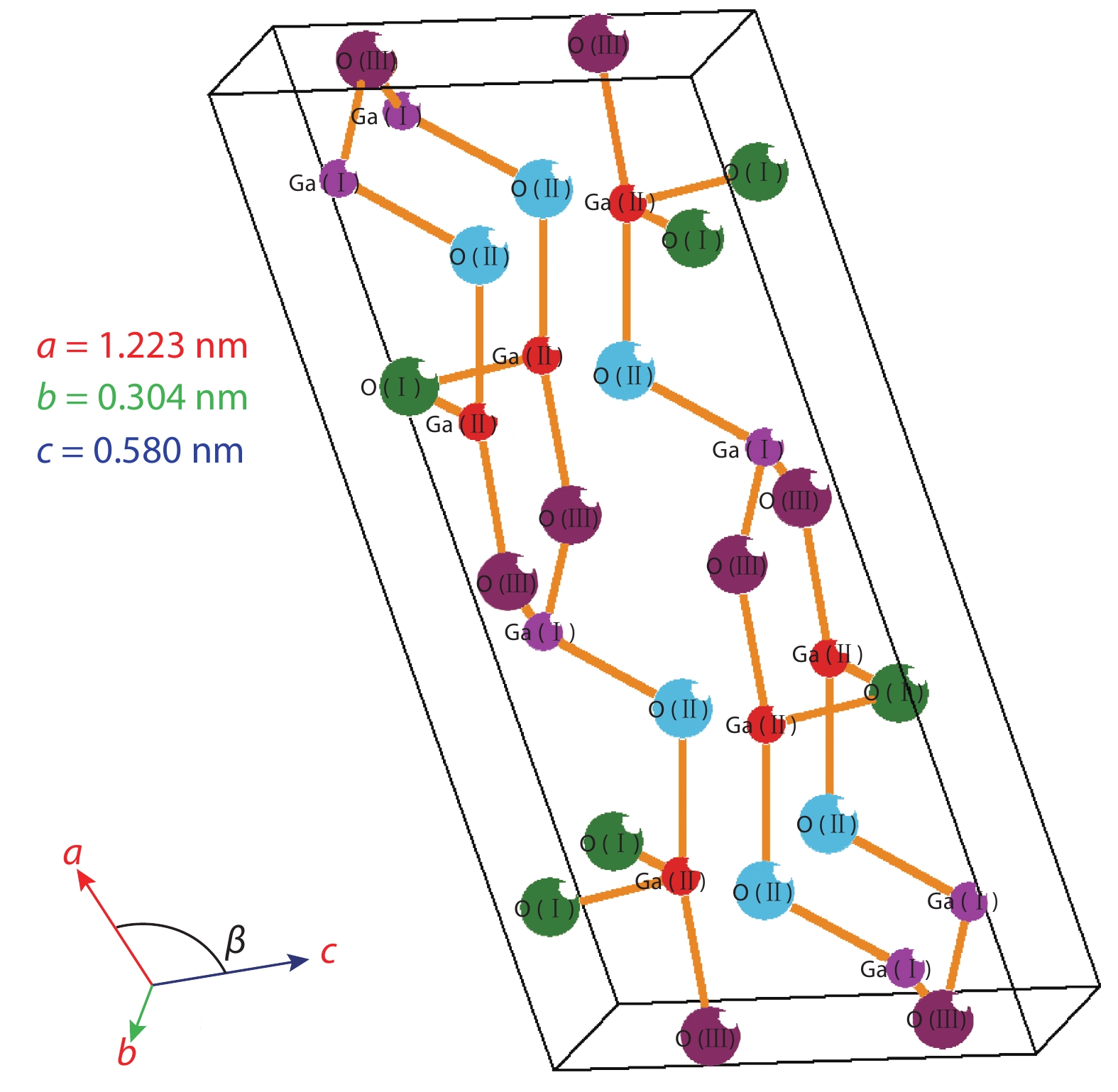
 DownLoad:
DownLoad:
